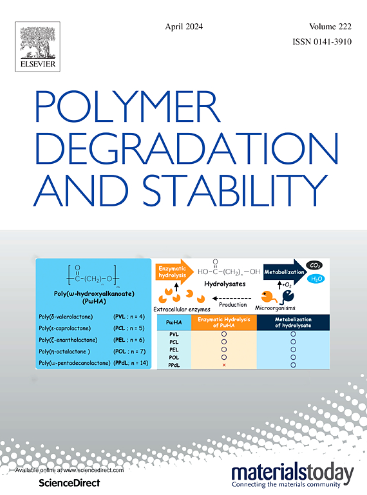含2-羟基-3-(4-羟基苯基)丙酸单元聚(3-羟基丁酸-co-2-羟基烷酸酯)的生物合成及性能评价
IF 6.3
2区 化学
Q1 POLYMER SCIENCE
引用次数: 0
摘要
聚羟基烷酸酯(PHA)的生物合成使用疏水氨基酸,如亮氨酸、苯丙氨酸和蛋氨酸作为2-羟基烷酸酯(2HA)前体,利用来自艰难梭菌的2HA单体供应酶(LdhA和HadA)。本研究以l-酪氨酸作为2HA前体,生物合成了含有2 -羟基-3-(4-羟基苯基)丙酸酯(2H3PhOHP)的聚(3-羟基丁酸酯-co-2HA) [P(3HB-co-2HA)],该化合物与酪氨酸具有相同的碳主链,侧链上有羟基。采用葡萄糖和l-酪氨酸培养具有PHA生物合成途径的重组大肠杆菌DH5α。通过1H核磁共振(NMR)对生物合成的PHA进行了表征,发现2H3PhOHP单元在PHA中的掺入量高达4.1 mol%。采用2-氯-4,4,5,5-四甲基-1,3,2-二氧磷烷对2H3PhOHP装置的酚基进行了修饰,并通过31P NMR分析证实了磷酸化。此外,还研究了聚合物的热力学性能和润湿性。在PHA中引入2H3PhOHP单元导致结晶度降低,玻璃化转变温度和表面润湿性升高。因此,2H3PhOHP单元是一种新型的PHA构建单元,它可以改变材料性质,并在侧链上提供羟基作为化学修饰位点,进一步改善PHA的材料性质。本文章由计算机程序翻译,如有差异,请以英文原文为准。
Biosynthesis and property evaluation of poly(3-hydroxybutyrate-co-2-hydroxyalkanoate) containing 2-hydroxy-3-(4-hydroxyphenyl)propionate unit
Polyhydroxyalkanoate (PHA) biosynthesis has been performed using hydrophobic amino acids such as leucine, phenylalanine, and methionine as 2-hydroxyalkanoate (2HA) precursors, utilizing 2HA monomer-supplying enzymes (LdhA and HadA) derived from Clostridioides difficile. In this study, l-tyrosine was used as a 2HA precursor in the biosynthesis of poly(3-hydroxybutyrate-co-2HA) [P(3HB-co-2HA)] containing 2‑hydroxy-3-(4-hydroxyphenyl)propionate (2H3PhOHP), which shares the same carbon backbone as tyrosine and has hydroxy group in the side chain. The recombinant Escherichia coli DH5α, having the PHA biosynthesis pathway, was cultured by feeding glucose and l-tyrosine. The biosynthesized PHA was characterized by 1H nuclear magnetic resonance (NMR), which revealed incorporation of the 2H3PhOHP unit into PHA up to 4.1 mol%. Modifying the phenol group of the 2H3PhOHP unit was performed using 2‑chloro-4,4,5,5-tetramethyl-1,3,2-dioxaphospholane, and phosphitylation was confirmed by 31P NMR analysis. Furthermore, the polymers' thermal and mechanical properties and wettability were investigated. Introducing 2H3PhOHP units into PHA led to a decrease in crystallinity and an increase in glass transition temperature and surface wettability. Thus, the 2H3PhOHP unit is a new type of building block for PHA that changes material properties and provides a hydroxyl group in the side chain as a chemical modification site to further improve the material properties of PHA.
求助全文
通过发布文献求助,成功后即可免费获取论文全文。
去求助
来源期刊

Polymer Degradation and Stability
化学-高分子科学
CiteScore
10.10
自引率
10.20%
发文量
325
审稿时长
23 days
期刊介绍:
Polymer Degradation and Stability deals with the degradation reactions and their control which are a major preoccupation of practitioners of the many and diverse aspects of modern polymer technology.
Deteriorative reactions occur during processing, when polymers are subjected to heat, oxygen and mechanical stress, and during the useful life of the materials when oxygen and sunlight are the most important degradative agencies. In more specialised applications, degradation may be induced by high energy radiation, ozone, atmospheric pollutants, mechanical stress, biological action, hydrolysis and many other influences. The mechanisms of these reactions and stabilisation processes must be understood if the technology and application of polymers are to continue to advance. The reporting of investigations of this kind is therefore a major function of this journal.
However there are also new developments in polymer technology in which degradation processes find positive applications. For example, photodegradable plastics are now available, the recycling of polymeric products will become increasingly important, degradation and combustion studies are involved in the definition of the fire hazards which are associated with polymeric materials and the microelectronics industry is vitally dependent upon polymer degradation in the manufacture of its circuitry. Polymer properties may also be improved by processes like curing and grafting, the chemistry of which can be closely related to that which causes physical deterioration in other circumstances.
 求助内容:
求助内容: 应助结果提醒方式:
应助结果提醒方式:


